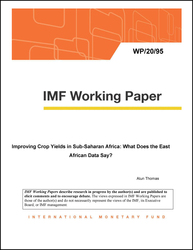
Improving Crop Yields in Sub-Saharan Africa - What Does the East African Data Say
Improving Crop Yields in Sub-Saharan Africa - What Does the East African Data Say
READ MORE...
Volume/Issue:
Volume 2020
Issue 095
Publication date: June 2020
ISBN: 9781513546223
$18.00
Add to Cart by clicking price of the language and format you'd like to purchase
Available Languages and Formats
| English |
Prices in red indicate formats that are not yet available but are forthcoming.
Topics covered in this book
This title contains information about the following subjects.
Click on a subject if you would like to see other titles with the same subjects.
Economics- Macroeconomics , Environmental Economics , Agribusiness , WP , yield , crop , crop yield , Rwanda , Ethiopia , East Africa , inputs , crop damage , yield determinant , Ethiopia crop , aggregate yield data , Agroindustries , Consumption , Agricultural sector , Agricultural commodities , Sub-Saharan Africa , Africa , Climate change
Summary
Recent micro level data from East Africa is used to benchmark aggregate data and assess the role of agricultural inputs in explaining variation in crop yields on smallholding plots. Fertilizer, improved seeds, protection against erosion and pesticides improve crop yields in Rwanda and Ethiopia, but not Uganda, possibly associated with lack of use there. With all positive yield determinants in place, wheat and maize yields could increase fourfold. The data hints at the negative effect of climate change on yields and the benefits of accompanying measures to mitigate its adverse impact (access to finance and protection against erosion). The adverse effect of crop damage on yields varies between 12/13 percent (Rwanda, Uganda) to 36 percent (Ethiopia). Protection against erosion and investment financing mitigate these effects considerably.
Copyright © 2010 - 2025
Powered by:
AIDC



